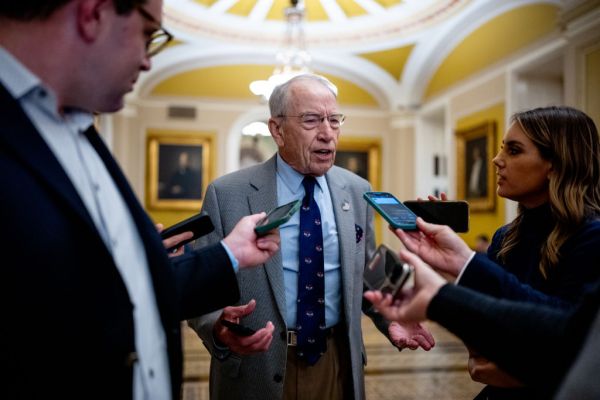Today, the federal higher education debate is dominated by talk of access, affordability, employment, and debt. Policy makers on the left often compete to see who can offer a more generous debt-forgiveness plan while those on the right bemoan bloated administrations, and families and students raise issues about affordability and value.
Yet, for tens of thousands of the nation’s most influential academics, and the hundreds of colleges and universities that employ them, those concerns are only tangentially related to their first mission, which is not instruction or credentialing but the production of research.
The federal government invests more than $40 billion a year in university-based research because there’s a bipartisan conviction that it can fuel advances that save lives, boost economic productivity, protect the environment, and much more. The value of Uncle Sam’s partnership with university researchers, however, depends on how scholars, universities, and federal agencies go about the work. Just as misaligned incentives and problematic practices have yielded concern about college costs, similar issues arise when it comes to university research. Yet these rarely get the attention they deserve.
Today’s research enterprise is notable for its remarkably transactional nature, with faculty focused on professional advancement and university leaders pursuing resources and prestige. As a result, the university research apparatus has evolved in ways that can impede research productivity, stymie creative scholarship, fuel administrative bloat, and compromise teaching and learning.
Federal research grants play an outsized role in the academy (more than half of university research expenditures come from federal dollars), because those dollars attract prestige and also because “overhead” payments allow universities to use up to 26 percent of research outlays to subsidize administrative costs. The result is that federally funded research is highly prized, as it puts institutions on the map, helps pay for graduate students and staff, and supports university operations.
On the one hand, grant-seeking brings an element of healthy market discipline. That “market”, however, is a peculiar one—one defined by the pursuit of federal funds, and so it is wholly dependent on federal rules, routines, and regulations. In 2018, the National Science Foundation (NSF) and the National Institutes of Health (NIH) fielded about 100,000 grant applications, and funded less than one-quarter of these. The sheer volume of material dictates that funding gets approached as something of an industrial process.
The nature of federally sponsored reviews, for those who haven’t experienced the joy of sitting in these cloistered rooms, is that they require scholars to read and score a number of hefty applications laced with appendices, and then judge which ones merit support. Because it can be hard to judge ventures based on paper promises, the process tends to favor familiar figures, high “citation counts”, and proposals that align with the methodological and ideological currents in the field. This all limits the opportunity to pursue bold or unconventional lines of inquiry and narrows the scope of questions that academics are inclined to ask. Indeed, as scholars reported in a 2016 paper, this kind of funding process can tilt the field against “‘high risk/high gain’ novel research.”
There is also an enormous burden associated with pursuing and documenting research. The IBM Center for the Business of Government has noted that the average research proposal takes 38 days to prepare. Given that success rates for NSF and NIH grants are in the 20 percent to 25 percent range, that suggests that researchers are devoting about 160 days to each successful grant proposal. If the impression is that an extraordinary amount of time and effort gets devoted to assembling paper, you’re catching on.
It’s once funds are secured, however, that the administrative burden really starts to kick in. The Federal Demonstration Partnership, a cooperative of 10 federal agencies and 150 institutions that receive research funds, found that university researchers reported that 44 percent of the time they spend on federally funded research is devoted to administrative tasks, including detailing project finances, getting approvals for project personnel, and managing data.
IBM’s Center for The Business of Government has also observed that, since 1991, the federal government has imposed 110newrequirements on university research grant recipients. For instance, Washington now requires applicants to submit mentoring plans for post-doctoral associates—even before it’s determined whether the grant proposal will be accepted, and despite the paucity of evidence that such plans have anything to do with the quality of mentorship scholars provide. And there’s little evidence that anything is being done to address this paperwork pileup. The previously mentioned FDP analysis reported, for instance, that most do not feel “that reducing administrative burden on researchers is a priority at their institution.”
Of course, these burdens have implications for students. It means faculty are devoting a lot of time not to research, teaching, or mentoring aspiring researchers, but to shuffling paper. One survey of more than 2,000 professors, conducted by the National Survey of Academic Scientists, found that science and engineering faculty spent twice as much time developing grant proposals and research administration as they spent on teaching, advising, or other student‐related activities.
University-based research has a distinctive role to play as we confront the industrial, environmental, military, and social challenges of the 21st century. But this requires that research is funded in ways that encourages and supports dynamic inquiry.As policymakers wade into reforming higher education, it’s time to look at all aspects of the academy: Let’s reassess how proposals are evaluated, streamline the burdens the process imposes, and reduce the bureaucratic burdens that stymie American research.
Frederick M. Hess is the director of education policy studies at the American Enterprise Institute. Brendan Bell is the program manager of education policy studies at the American Enterprise Institute.
Photograph of Dr. Anne Simon, professor of cell biology and molecular genetics at the University of Maryland by Matt McClain/Washington Post via Getty Images.






Please note that we at The Dispatch hold ourselves, our work, and our commenters to a higher standard than other places on the internet. We welcome comments that foster genuine debate or discussion—including comments critical of us or our work—but responses that include ad hominem attacks on fellow Dispatch members or are intended to stoke fear and anger may be moderated.
You are currently using a limited time guest pass and do not have access to commenting. Consider subscribing to join the conversation.
With your membership, you only have the ability to comment on The Morning Dispatch articles. Consider upgrading to join the conversation everywhere.